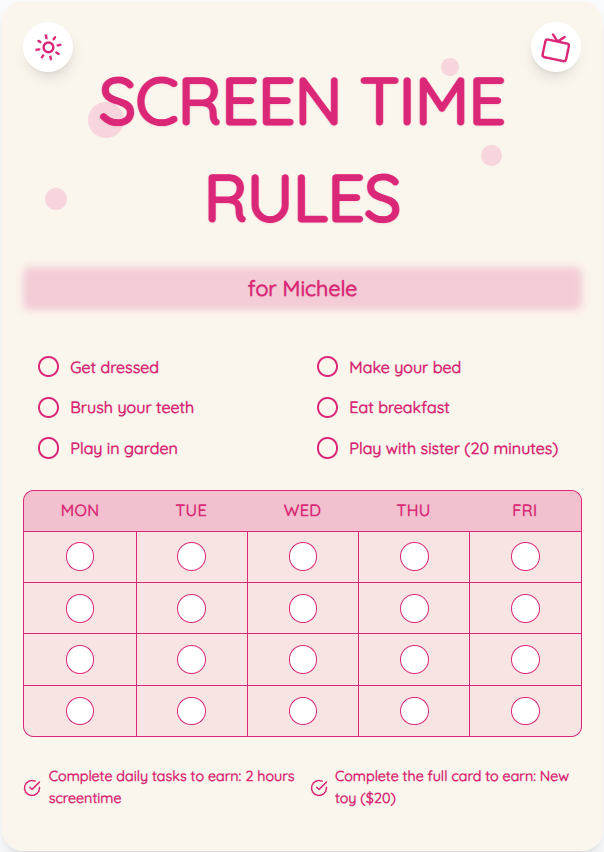Finding the Right Balance: Screen Time Guidelines for Kids
As a parent, navigating the digital world with your child can be challenging. Understanding how much screen time is appropriate for kids is crucial for their development and well-being. In this guide, we'll provide you with actionable advice and practical tips to help you set healthy screen time limits for your children aged 2-12.
See What Your Screen Time Chart Will Look Like
Here's an example of a beautiful, customizable screen time rules chart you can create for your family

Understanding Screen Time Recommendations
The American Academy of Pediatrics recommends that children aged 2-5 should have no more than one hour of screen time per day, while older children can have consistent limits but also quality screen time. It's essential to balance screen time with other activities like outdoor play, reading, and family time to promote healthy development.
Setting Realistic Screen Time Limits
Create a screen time schedule that works for your family. Consider factors like schoolwork, physical activity, and bedtime routines when setting limits. Use screen time charts as visual aids to help your child understand and adhere to the rules. Encourage open communication about screen time expectations and involve children in the decision-making process.
Put These Tips Into Action
Create a custom chart to implement these strategies with your child
Promoting Healthy Screen Time Habits
Encourage educational and age-appropriate content when allowing screen time. Monitor your child's online activities and engage in co-viewing to discuss what they are watching or playing. Be a positive role model by demonstrating responsible screen use yourself. Limit screens in bedrooms and during meal times to foster better family connections.
Practical Tips for Success
- Create a screen time chart with designated time slots for different activities
- Use parental controls to limit access to inappropriate content
- Encourage offline hobbies and interests to reduce dependence on screens
- Set a good example by following similar screen time rules
Frequently Asked Questions
How can I handle resistance from my child when enforcing screen time limits?
Acknowledge your child's feelings but stay firm on the rules. Offer alternative activities or rewards for adhering to the limits. Consistency is key in establishing healthy screen time habits.
Is it okay for my child to use screens for educational purposes beyond the recommended limits?
Using screens for educational purposes can be beneficial, but it's essential to monitor content and ensure a balanced approach. Incorporate interactive and hands-on learning activities to complement screen-based education.
What are the signs of excessive screen time in children?
Signs of excessive screen time include irritability when screens are taken away, lack of interest in other activities, disrupted sleep patterns, and declining academic performance. It's important to address these signs early and reassess screen time limits.
Finding the right balance of screen time for your child is a journey that requires patience and consistency. By implementing the tips and strategies outlined in this guide, you can create a harmonious digital environment that promotes healthy development and family connections. Visit ScreenTimeRules.com to generate personalized screen time charts and start managing screen time effectively today.
Ready to Transform Your Family's Screen Time?
Join thousands of parents who have successfully managed screen time with our customizable charts.
